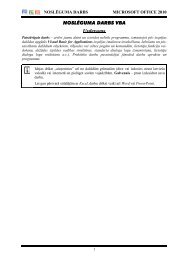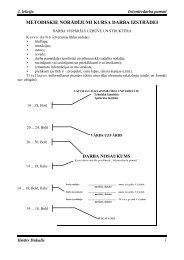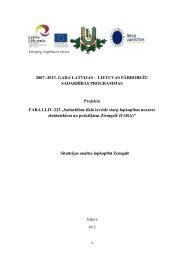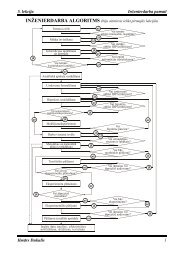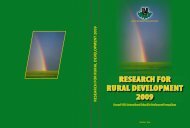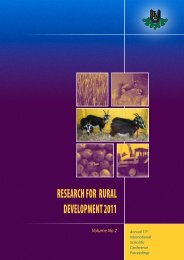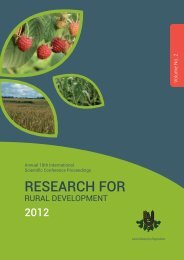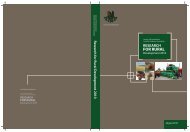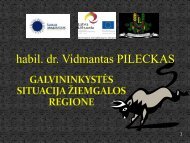LATVIA UNIVERSITY OF AGRICULTURE - Latvijas ...
LATVIA UNIVERSITY OF AGRICULTURE - Latvijas ...
LATVIA UNIVERSITY OF AGRICULTURE - Latvijas ...
- No tags were found...
Create successful ePaper yourself
Turn your PDF publications into a flip-book with our unique Google optimized e-Paper software.
AGRICULTURAL SCIENCES (CROP SCIENCES, ANIMAL SCIENCES)IMPACT <strong>OF</strong> SLURRY APPLICATION METHOD ON SWARD YIELD AND NAND K LEACHING FROM GRASSLANDTampere MailiisEstonian University of Life Sciencese-mail: mailiis.tampere@emu.eeAbstractStudies comparing slurry injection versus spreading have reported inconsistent results so far. The objective of thestudy was to compare two slurry application methods, injecting and spreading, in terms of influence on sward yieldsand leaching of nitrogen (N) and potassium (K) from grassland. The experiment was conducted from 2008 to 2011at the Eerika Experimental Station, Estonian University of Life Sciences. Mini-lysimeters filled with loamy sand soilembedded in three swards (three-species grass mixture (Phleum pratense, Lolium perenne and Poa pratensis), grassesmixture with white clover (Trifolium repens), and grasses mixture with lucerne (Medicago sativa)) were used. Threeannual nitrogen rates (60, 120, 180 kg ha -1 ) in conjunction with the two slurry application methods (injecting andspreading) were applied. Percolated water quantities, N and K content in leachate and the sward yield were measured.N leaching was significantly less with slurry injection while K leaching did not depend on slurry application method.N and K leaching was more affected by sward botanical composition and applied N rate and N:K ratio n slurry thanby slurry application method. Sward yields did not depend significantly on slurry application method. Slurry injectionis rational only in grasses sward when used N rates are above 120 kg ha -1 yr -1 . Slurry injection may have negativeinfluence on the distribution of white clover in the grasses + white clover sward and thus lead to sward yield decrease.Key words:Grassland, leaching, nitrogen, potassium, sward yield.IntroductionSlurry is an organic and environmentally friendlysource of plant nutrition. Since the increasing animalproduction also increases the slurry amounts, it isimportant to study it. Depending on the method ofapplication, slurry remains either on the surface(spreading) or within the sward (injecting). Themethod of injecting slurry into the soil can efficientlyprevent NH 3volatilization (Frost, 1994) and surfacerunoff losses of NH 4- N (Turtola and Kemppainen,1998). However, large quantities of nutrients that arebrought into the soil via slurry organic matter canmineralize when plants do not need them and can,therefore, lead to nutrient leaching (Bergström andKirchmann, 1999). Interestingly, it has been foundthat nitrogen (N) in injected slurry is better utilized byplants than with surface application (Schils and Kok,2003).Unlike N and phosphorus (P), there has been noconcern raised about potassium (K) as a potentialpollutant. Losses of K can be considered to be ofeconomic importance (McGechan and Wu, 1998). Ithas been found that although K leaching on grasslandis usually low, high levels of available K in the soil,and large quantities of fertilizers may increase Klosses significantly (Kayser and Isselstein, 2005).The effect of slurry application method on swardis unclear, as opposing results have been presented.R.L.M. Schils and L. Kok (2003) found that yieldsare higher on the plots with injected slurry rather thanon plots were slurry is surface - applied. Injectionincreases herbage N content due to the higher Nrecovery of injected slurry (Kemppainen, 1989; Reeset al., 1993). Other results indicate that injectionproduces significantly lower yield than surfaceapplication (Rodhe et al., 2006) or there is no effect onyield from injection technique compared with surfacespreading (Mattila et al., 2003). It has been proposedthat the mechanical damage by injection could be theunderlying cause (Halling and Rodhe, 2010).My hypotheses were that (i) sward yield is higherwith slurry injection when compared to spreading and(ii) N and K leaching is less when slurry is injected.The aim of the study was to examine whetherinjecting or spreading of slurry significantly influencedsward yields with different botanical composition andN and K leaching from those grassland swards.Materials and MethodsThe experiment was conducted from May 2008to January 2011 at the Eerika Experimental Station,Estonian University of Life Sciences (58°23’32” N,26°41’31” E; elevation 60 m). Plastic mini-lysimeters(surface area 0.0706 m 2 ; depth 30 cm) filled withloamy sand soil (sand 64%, silt 29%, clay 7%, specificsurface area of 30.6 m 2 g -1 ) were dug into the ground,so that soil surface of the lysimeters was at the samelevel as the surrounding soil. At the beginning of theexperiment the soil organic matter (OM) was 170 000– 190 000 mg kg -1 , total N content was 11 000 mg kg -1 ,available P was 94 - 102 mg kg -1 and K was 165 - 180mg kg -1 (Egner – Rhiem – Domingo).The study involved the injecting or spreading ofslurry equating to annual N rates of 60, 120 and 180kg ha -1 onto plots of three types of sward (i) grassesmixture with Phleum pratense, Lolium perenneand Poa pratensis; (ii) grasses mixture with addedTrifolium repens and (iii) grasses mixture withMedicago sativa. Slurry was applied manually. Theapplication rate was calculated based on NH 4– N38 Research for Rural Development 2012



